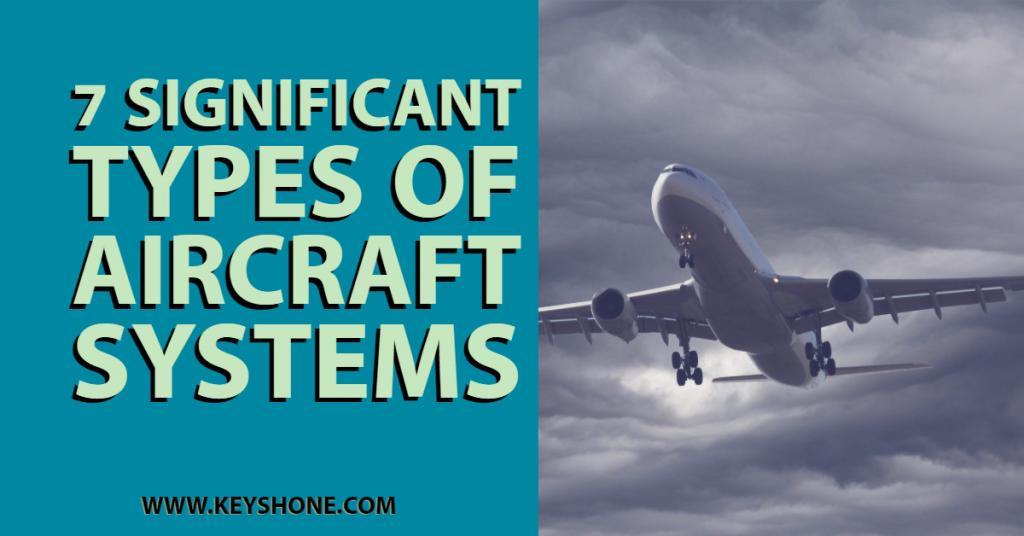
Aircraft systems is a multifaceted system. In the scheme stage and in the operating process ensure the continued airworthiness of the aircraft. It is broken down into simpler subsystems that carry out homogeneous functions.
Aircraft Type Segments Are Wide Body Aircraft, Narrow Body Aircraft, Regional Jets
Application Segments
- Commercial Aviation
- Business Aviation
- Military Aviation
- Other Applications
Table of Contents
Must Read: New Inventions in Aerospace Industry
1. Flight Control System
For a Conservative permanent aircraft, the FLIGHT CONTROL SYSTEMS it’s comprised of Flight control surfaces, cockpit control, related linkages, and the essential operating mechanism to switch an aircraft track or maneuvering in flight condition and ground activity. Engine controls are also controlled as they change in velocity (speed).

2. Avionics System
Electronic systems usage in Aerospace Industries, aircraft, satellites, and craft embraces (NAVCOM) Communications systems, Navigation systems, Display, and merged all systems that are built-in to aircraft to accomplish a single utility.
Instruments are Magnetic & gyroscope compass, aircraft clocks, Altimeters, Autopilot systems, Machmeter, Radar altimeters, vertical airspeed indicators, HUD displays, helmet-mounted displays, CVR, FDR, MFD, PFD, etc.
3. Hydraulic System & Landing gear System
Entirely aircraft are fortified with the hydraulic system while small overall aviation airplanes may have small modest hydraulic systems larger jets have a precise complex hydraulic system in Light Transport aircraft the hydraulic system commands the brakes to end the airplane.
Extension and retraction of the Landing gear of an aircraft by pressure range 3000-5000Psi and change the blade angle on some constant speed propeller as discussed on larger airplanes like those used in airlines the hydraulic system powers a majority of the airplane including the
Flight Control System flaps Usually a hydraulic system consists of a reservoir where hydraulic fluid has stored a pump that moves the fluid a filter to keep contaminants out of the system a relief valve in case of hydraulic malfunction and actuators which the hydraulic system operates works by pumping hydraulic system works by pumping incompressible fluid through hydraulic lines (Pressure Line, Return line) from one actuator to another causing the actuator pistons to extend or contract the hydraulic pressure exerted throughout the actuators is significant making Hydraulic System very powerful.

Brake system typical aviation airplane; the pilot presses on the brakes a piston drives fluid from the brake actuator on the pedal through hydraulic lines and then to the actuator nearby the wheels the fluid drives the piston which results in automatic jams the brake pads in contrast to the brake Disc affecting the airplane to gentle down.
Must Read: Drones in India | When & How Launch
4. Environmental Control System
ECS or Air management system is an all-purpose term used in the Aviation industry for a system and equipment concomitant with cooling, Ventilation, Humidity control, and cabin pressurization in the interior aircraft occupied sections, Electronic Equipment’s bays, cargo sections, etc. In general, the system is designed to maintain the compartment’s range of temperature 18 to 30° up to the aircraft ceiling of altitude 9.144 Kilometer.
The Air circulation to the Cabin is normal through ECS, Emergency backup pressurization system through Ram Air apart from these Engine Bleed air is also used by ECS to provide pressurization to the cabin.

Refrigeration of the air is created by a bootstrap air cycle system. Bleed air temperature control is consummated automatically by an Electronic controller in union with an Electro-Pneumatic Temperature control valve.
5. Power Plant System
A system that interims an aircraft power plant is an Engine. Basically made up of many components which include cylinders’, fans, or propeller pistons, it might be a jet engine or a combination of a propeller and an Engine.
The aircraft engine and propeller frequently referred to as aircraft power plant works in combinations to produce thrust for an aircraft. The Power plant propels the airplanes and drives the various systems that support the operation of an airplane.
6. Fuel Systems
The fuel system is the fuel carried by an Integral tanks assembly in the wings, in the fuselage for fighters where separate integral tanks space is available for fighter aircraft where it covers the main tank, collector tank, and supply tank located at the wing of an aircraft where supply tank is provided with booster pumps one for general standby and another for the Emergency case.

The fuel tank is associated with fuel lines that connect it to the engines. Each fuel tanks have a capacity based on the location.
7. Electrical Systems
The Electrical System is the Power for numerous systems of an aircraft that is delivered from DC sources. In general, Engines are fitted with DC generators capable of Providing 28V DC and auxiliary batter are also available to afford Emergency backup power in the condition of generators’ failure case.



Informative ..!!